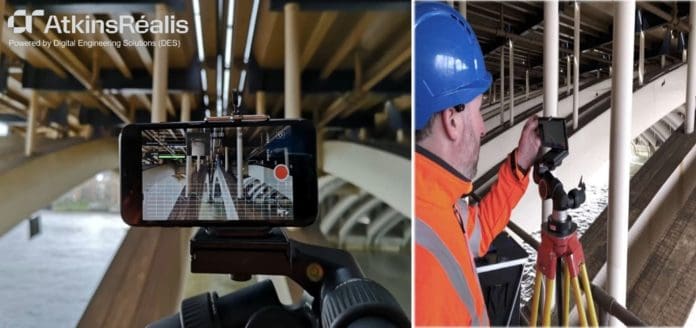Monitoring the structural health of key infrastructure assets, such as bridges, is crucial in making maintenance and capacity decisions, and extending service life. Dr Jan Winkler of AtkinsRéalis says digital tools, combined with everyday smartphones, could prove invaluable
UK infrastructure owner-operators face an uphill battle over the next few decades as many of the nation’s assets approach end of life.
With substandard bridges rising to be a £6.8bn problem and not to mention our Victorian-era rail infrastructure – efficient structural health monitoring and asset condition reporting are crucial for engineers to prioritise interventions.
Asset deterioration caught too late can lead to reactive and intrusive maintenance. Conversely, false positives can result in unnecessary interventions that waste resources.
Our industry needs higher-quality data to inform these decisions. However, we still heavily rely on equipment requiring surface contact, such as displacement sensors and strain gauges, which can disturb public and economic activity.
There is a significant opportunity for digital tools to augment structural health monitoring on a global scale and Digital Image Correlation (DIC) can help to plug this gap.
DIC involves using cameras – ranging from conventional cameras to CCTV and drones – to make assessments of localised and large areas to understand asset movement, rotation, stress and service life.
Data is collected and analysed by computer vision algorithms to provide short-term or long-term insights into an asset’s performance, with imagery picking up detail to the pixel or fraction of a millimetre. Its benefits are clear: little to no public disruption, reduced time and costs, highly scalable, improved safety, and higher quality data.
Although DIC is not new, its adoption has been steadily rising due to technology advancements. We are also seeing rising client demand for the next iteration: smartphone-based tools enhanced by artificial intelligence.
Saving cost and time on the DLR
AtkinsRéalis used DIC to help the Docklands Light Railway (DLR) in London assess if its bridge stock could tolerate an increase in train cars from two to three.
Initial structural calculations by theoretical computer modelling concluded that significant strengthening was needed for several bridges at significant cost and disruption to the network.
However, using a camera positioned 40m away over the course of one day, real bridge deflections and stresses were revealed to be 40% lower than predicted.
We monitored both the vertical deflection and peak strain and DIC revealed the presence of previously unmodeled structural stiffness.
DIC transforms OLE understanding
In another case, AtkinsRéalis used DIC earlier this year to help Network Rail develop new nationwide rules for Overhead Line Equipment (OLE) designers. We deployed DIC to monitor two points on two tracks at bridge arms.
On completion, we recommended the existing uplift design value could be reduced for all bridge arms, minimising the required clearance between OLE equipment and overbridge soffits.
This was the UK’s first large-scale project measuring OLE uplift at overbridges and has reduced or eliminated the need to implement costly infrastructure changes for future electrification schemes, such as bridge reconstructions or track lowering, as the new rules are incorporated.
The DIC smartphone revolution
Despite its efficiency, DIC typically requires specialist equipment and training, making it inaccessible to some engineering professionals and difficult to scale.
Smartphone DIC applications promise to democratise this. With smartphones’ lower up-front costs, high portability and intuitive interfaces, DIC technology could be made more accessible to engineers of varying levels and applicable on a large scale – exponentially increasing the depth of our structural health understanding and analysis.
Some challenges remain. DIC mobile applications can be undermined by environmental factors, such as lighting or weather conditions. However, these can be mitigated by accounting for camera movements and iterative improvements.
The results of an assessment can also be impacted by smartphone hardware quality, meaning some assessments should be left to more advanced equipment. These emerging apps must also be rigorously tested and validated to ensure they meet standards.
But there is significant potential for this technology to be enhanced by artificial intelligence, with its ability to process large amounts of data and identify anomalies, making this technology even more approachable.
At AtkinsRéalis, we have bolstered our mobile DIC capability by partnering with pioneering startup Digital Engineering Solutions (DES) to use its ISO-certified app.
The DES app captures and analyses structural displacements with millimetre accuracy of up to 10m away, giving our engineers an immediate indication of asset condition and additional insights into how a structure is performing regardless of its complexity or hidden load paths, as well as validating information from other models or instruments.
Over the past two years, we have used the DES smartphone app on several sites such as:
1. Newport Bridge in Middlesborough: Deformations were monitored in various locations within a few hours to understand the structural response to a bearing failure and to support a structural monitoring campaign.
2. Multi-storey car park in Birmingham: Displacement due to vehicle load was captured and used to support structural assessment with the goal to extend car park service life.
3. Construction of a new skyscraper in Dubai: The app was used to supplement a client monitoring system during a critical construction phase.
4. Great Belt Suspension Bridge in Denmark: The app monitored a bearing rotation which triggered an immediate maintenance action, ensuring safe operation of critical structural components.
DIC is by no means a magic bullet, but its proliferation represents a transformative shift in how our industry could approach structural health.
Today, infrastructure owner-operators have a sharp focus on cost and carbon footprint, so they need quality data to maximise the value of existing assets through efficient and proportionate asset intervention, relying on data-driven insight. DIC shows what innovation can be achieved by leveraging existing resources and developing accessible digital tools.
Dr Jan Winkler
Professional head of structural health monitoring
AtkinsRéalis

















